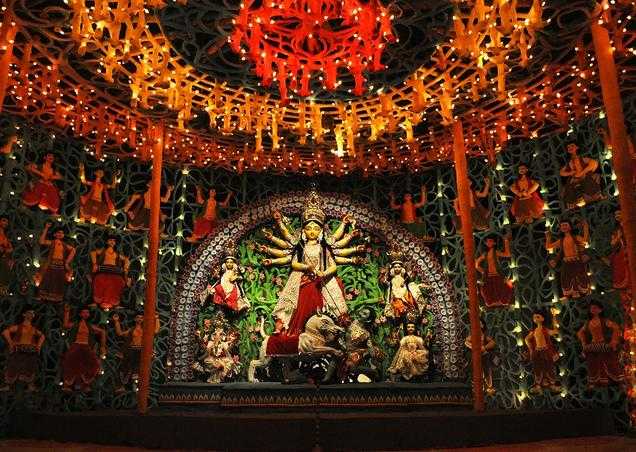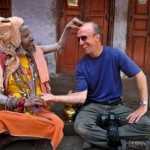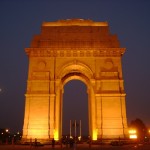After every night, comes a new day. After every storm, there is light. And just maybe that’s why the Dussehra comes right after the stormy monsoon season – the celebration of Durga’s victory over Mahishasur, Ram’s over Ravan, good over evil.
As a child, I used to love Dussehra simply because father would buy toy bows and arrows for us kids, and then fashion a Ravan out of newspaper, cotton, paint and scrap. We would then proceed to aim our bows at the poor fellow, Ravan I mean, not dad, and release our brahmastra, vayu astra, agni astra, plastic arrow astra and basically destroy the living daylights out of him. Over the years, we grew up and Dussehra stopped being as important.
But a few years back, I was a spectator to Ahmedabad’s Navratri and this year, I happened to be dragged into Delhi’s very own ‘Little Kolkata’ - CR Park, where the Durga Pujo is inarguably the festival everyone is waiting year round for. In these two places, we saw colour, we saw larger than life idols; we saw conches and we saw dandiyas; we saw vermillion and we saw chaniya cholis, we saw drunk men, and happier women; we saw enterprise – hundreds of stalls selling street food, water, soft drinks, ‘chineeze’ dishes, costumes and what not. Most of all, we saw a carnival, an opportunity for different communities to come out of their homes for a week every afternoon, every night and celebrate life.
If you’d like to be part of this week long carnival, these are some of the best places in India to enjoy in the revelry.
1) Kolkata, West Bengal
In Kolkata , Durga Puja is more than just a festival. This ten day celebration begins with Mahalaya (day one) and ends on Bijoya Dashami. Everywhere you walk in this city, under the autumn sky, Pujo is omnipresent. Pandals are scattered all over the city, each with their own theme, and Pandal Hopping is the done thing. The good pandals exist in clusters, so if it’s the famous Ahiritola Sarbojanin puja you want to attend, (five minutes from the Shovabazar metro station), you can couple it up with the Kumartuli Sarbojanin and Chaltabagan Lohapatty pujas, only a short walk away. A prettier way to see the proceedings is to go via ferry on the Hooghly river.
In the middle of it all, in the blur of it all, with people praying to a giant colourful golden idol, conches blowing, drummers sweating, dancers swaying in perfect sync, someone spilling a spicy puchka, people laughing, the flirting, the grand white sarees with red borders, the extravagant makeup, the noise and the smoke, in the sidur khela and married women spraying vermillion on each other, there is a vibe about Kolkata in these moments which is difficult to capture anywhere else.
2) Varanasi, Uttar Pradesh
Varanasi has always been a magnet for the spiritual, the religious, for holy seers and for the hippies. During the ten days of the Dussehra, the city becomes famous for its Ram Leela. Fifteen kilometers from the main city lies Ramnagar, where the Ram Leela is enacted in a unique manner. Unlike the rest of the country, where the enactment is done on single stages, here in Ramnagar the whole town is transformed into a large Ram Leela ground, structures are built and different spaces represent different locations in the story. The whole Ram Leela takes place over a month.
Sadhus coming to Ramnagar from all over the country during this time and reciting Ramcharitramanas are called Ramayanis and the audience follows the performers all over town . Even though thousands of devotees, bystanders, tourists throng the town during this month, it is incredible to note that most of the recital is done without the aid of any loudspeakers, electric lights or mikes, and the audience maintains a hushed silence throughout the Ramayani recital.
On the day after Dussehra, Varanasi celebrates the Bharat Milaap festival, which commemorates Ram’s return to Ayodhya and his reunion with younger brother Bharat. This takes place at Nati Imli, and thousands of people flock and gather to see Ram meet Bharat. People wear tilak on their foreheads and garland the brothers. Watching the entire scene from the background every year is Kashi Naresh (former king of Varanasi) in his regal attire and finery.
3) Bastar, Chhattisgarh
In Bastar, Chhattisgarh, tribal villagers celebrate Dussehra not for nine days, but a whopping 75 days! Here, instead of rejoicing over Ravana’s death, they celebrate Dussehra as a congregation of Devi Maoli (revered as the “elder sister” of Devi Danteshwari), and all her sisters. Hundreds of priests bring flower-bedecked local deities to the Danteshwari temple in Jagdalpur, with all pomp and show. The main attraction of this festival is the Rath Yatra. A double decker chariot (Rath) weighing over 30 tonnes is made by villagers, and only traditional tools are used to make this chariot. Last year it took 170 villagers almost two weeks to make the chariot. The State Tourism Department light a thousand lamps to illuminate the path of the Rath and both town people as well as tourists follow the Rath as it goes around Jagdalpur. It is believed that good luck will follow all those who help in dragging the chariot.
4) Ahmedabad, Gujarat
Ahmedabad is never as alive as it is during Navratri. The city is decked to the core, throughout the nine days, and all that everyone does is wait for the evening for the Garba and Dandiya Rasa, when they can take their dandiyas and go dance, the girls in their sequined or backless chaniya cholis, the men in their traditional kedias. In Gujarat, people worship goddess Amba during this festival. According to superstition, women will be blessed with a child if they have darshan of the goddess on Ashtami. NRI’s have their own Garba Ras events in community clubs in USA and UK every year, but there aint anything like the original version in Gujarat.
Behind the pomp, the show, the glitz and the noise, there are thousands of men and women sitting in dark rooms and small factories creating the extravaganza, bit by bit, piece by piece.
At the end of it all, lying scattered on the earth are paper plates, streamers, burnt crackers, remnants of what was once a Ravan, and all that will be swept away the next day. The party will end, and life will continue. But for those nine ten days, in some parts of India, the streets are full of people dressed in their best, making a lot more noise than usual, happily letting go of regular life. And maybe that is the way for a traveler to enjoy the puja most in these towns and cities, by letting go and allowing the maddening crowd, the sights, the superstitions to overwhelm your senses.
p.s The post said 5 places. Well, one must always be loyal to one’s own brethren, so presenting to you, at number
5) Chittaranjan Park, New Delhi
Sitting here for the past 4-5 days of the Puja, weaving my bike through hordes of men hell bent on walking in the middle of the road, losing all hearing thanks to the local version of the vuvuzela, and biting into chicken roll after roll, fish orley after fish orley, I have become used to a routine that I will miss once these festivities are over. I still don’t understand why my Bong friends insist we visit every possible Pandal, most still look the same to me, but I tag along and click some more, eat some more, learn some more. Come down to our side of town next year, yo! Till then, Shubho Bijoya!


























